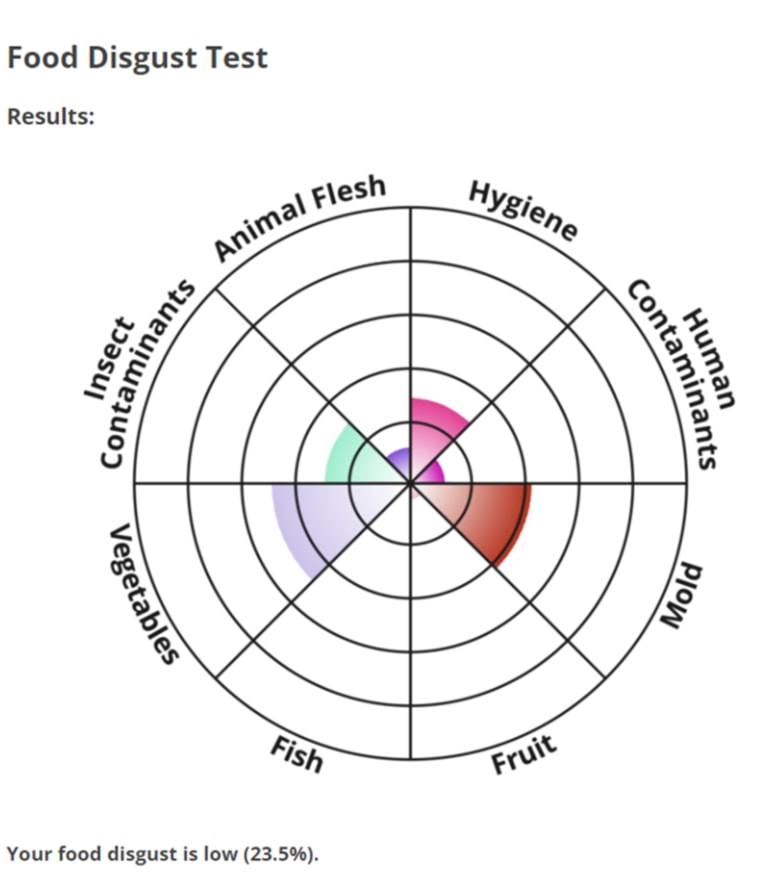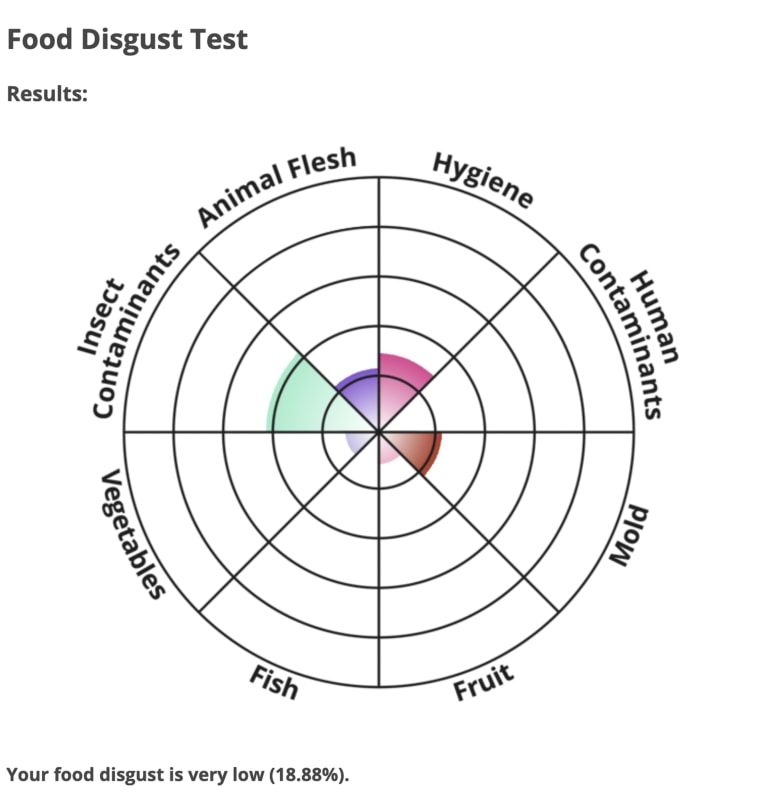An online test that aims to tell you your level of tolerance for food-related triggers that can cause disgust has gone viral. People are eating that s--- up.
On April 17, Twitter account @buttpraxis (hey, just reporting the facts, here) shared a tweet that started a test-taking trend on Twitter. In their viral tweet, the user shares a link to the "Food Disgust Sensitivity Test," developed by IDRlabs, a German company that provides individual personality assessment tests intended to determine individual personality types.
“This is ten thousand times more fun than the meyers briggs pls post yours,” the user tweeted. Although the test was published all the way back on March 8, 2021, according to IDRlabs, nearly 2,000 people responded to the original tweet with their own results, and there are more than 21,000 quote-tweets.
According to IDRlabs, the test is based on the work of doctors Christina Hartmann and Michael Siegrist, two researchers who created the Food Disgust Scale, a way of assessing “an individual’s emotional disposition to react with disgust to certain food-related (offensive) stimuli,” according to findings published in “Food Quality and Preference” in 2017.
Essentially, this test tells you how grossed out you are by certain foods and food-related situations, using eight categories to do so: animal flesh, hygiene, human contaminants, mold, fruit, fish, vegetables and insect contaminants.
Now, on Twitter, folks far and wide are posting about the quiz — and discussing the implications of their results, as well as some of its questions.
“WHEEZE,” tweeted one user, clearly shocked at their 89.13% "extremely elevated" disgust rate.
“I guess i’m not as indiscriminate as i believed,” wrote another user, sharing their results of 69.63%.
“i once started crying when my mom tried to make me cut raw meat with her because the texture and the smell and just how it looked made me so uncomfortable and nauseated,” wrote one user with a result of 91.38%.
Still, others shared their results which sat on the lower side — a commonality among them being, many theorize, a love for, or at least exposure to, international cuisines.
“...y’all aren’t eating the best part of the fish? Head meat hits different lmao, just like brain and tongue,” tweeted one user.
“Growing up in a very Chinese family means I’m comfortable eating pretty much anything you put in front of me,” tweeted cooking show host Jimmy Wong, who had a “very low” result of 19.3%.
“Sorry for my cultural ignorance, but what does being Chinese have to do with it?” another user replied to Wong. “Do you have a very wide range of cultural foods and flavors?”
“Many regional cuisines, many ingredients not commonly found in western food, chinese cooking has a lot of chefs that try find ways to cook and eat literally every part of an animal,” responded Wong.
“Me, doing the food disgust quiz while inhaling a bowl of nattō over rice for supper: quelle surprise,” tweeted another user, sharing their low result. (Natto is a Japanese staple dish of fermented soybeans with a slimy texture.)
Portions of the test have been critiqued by folks whose cultures greatly rely on the consumption of fish, pork or even insects, with one Twitter user saying, “This 'Food Disgust Test' is pretty racist? Or at least American white-centric.”
Prompts like “It is gross to eat raw fish like sushi” and “My mouth waters when I see a whole pig on a skewer” seem targeted at Japanese, Polynesian and other cuisines these foods are deeply associated with.
The phrasing of “I would never eat those new snacks and dishes that are made from bugs" (emphasis ours), for one, is inaccurate, considering that Mexican chapulines, deep-fried grasshoppers seasoned with chile and lime, have been around since the 16th century.
Personally, as a Haitian American, the question, “It is nauseating to have a whole fish, including its head, served to me on my plate,” felt especially pointed. As someone who enjoyed pwason fris, a whole fried red snapper, head and all, throughout my childhood, the word “nauseated” gave me a little bit of pause.
IDRlabs did not immediately rely to a request for comment.
Still, the test, in explaining the results, seems to acknowledge this.
“Of all the food disgust triggers, Animal Flesh is thought to have the most cultural basis, and many vegans and vegetarians report increased disgust on this parameter after adopting these diets,” IDRlabs says.
As for my results, I sat on the low side, with a 27.63% disgust rate. I do, after all, eat things like ranch dressing-flavored ice cream for a living, so that is no surprise.

Meanwhile, TODAY.com’s senior food editor, Emi Boscamp, had an even lower result than I did, with 23.5%. She told me earlier that she was an “eyeball girlie,” so this tracks.

The lowest results on our team, however, go to associate photo editor Zeina Zeitoun who got a 18.88% “very low” disgust rating.

Under the test, IDRlabs advises taking these results with a grain of salt, if you will.
“The Food Sensitivity Test is based on a famous and well-regarded inventory for the assessment of food disgust sensitivity. However, free online tests and quizzes such as this one are solely first takes and cannot provide accurate assessments of your food sensitivity,” it writes.
“Hence, the test is intended to be used for educational purposes only," it continues. "A definitive food disgust assessment can be made only by a qualified mental health professional.”
